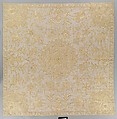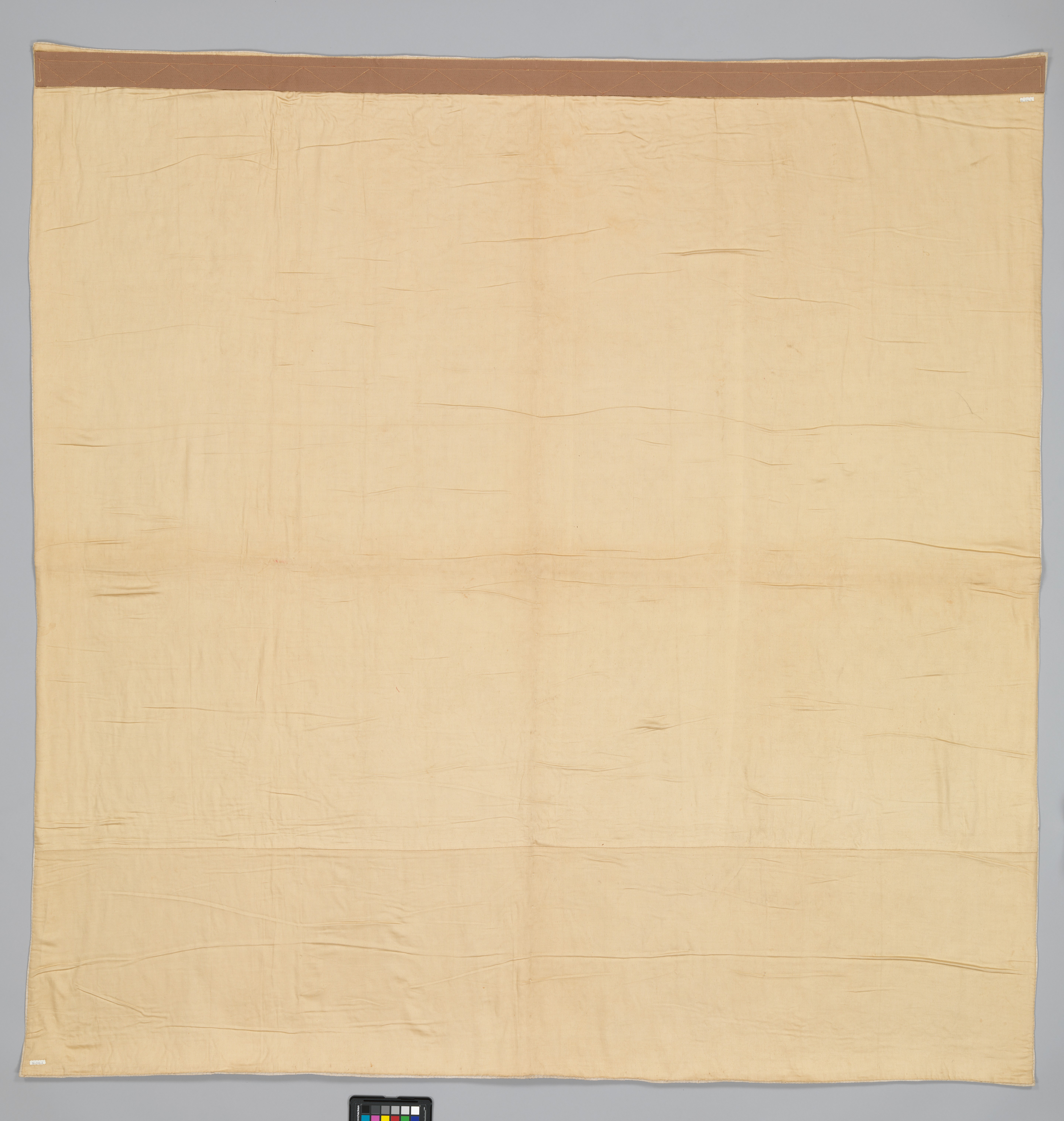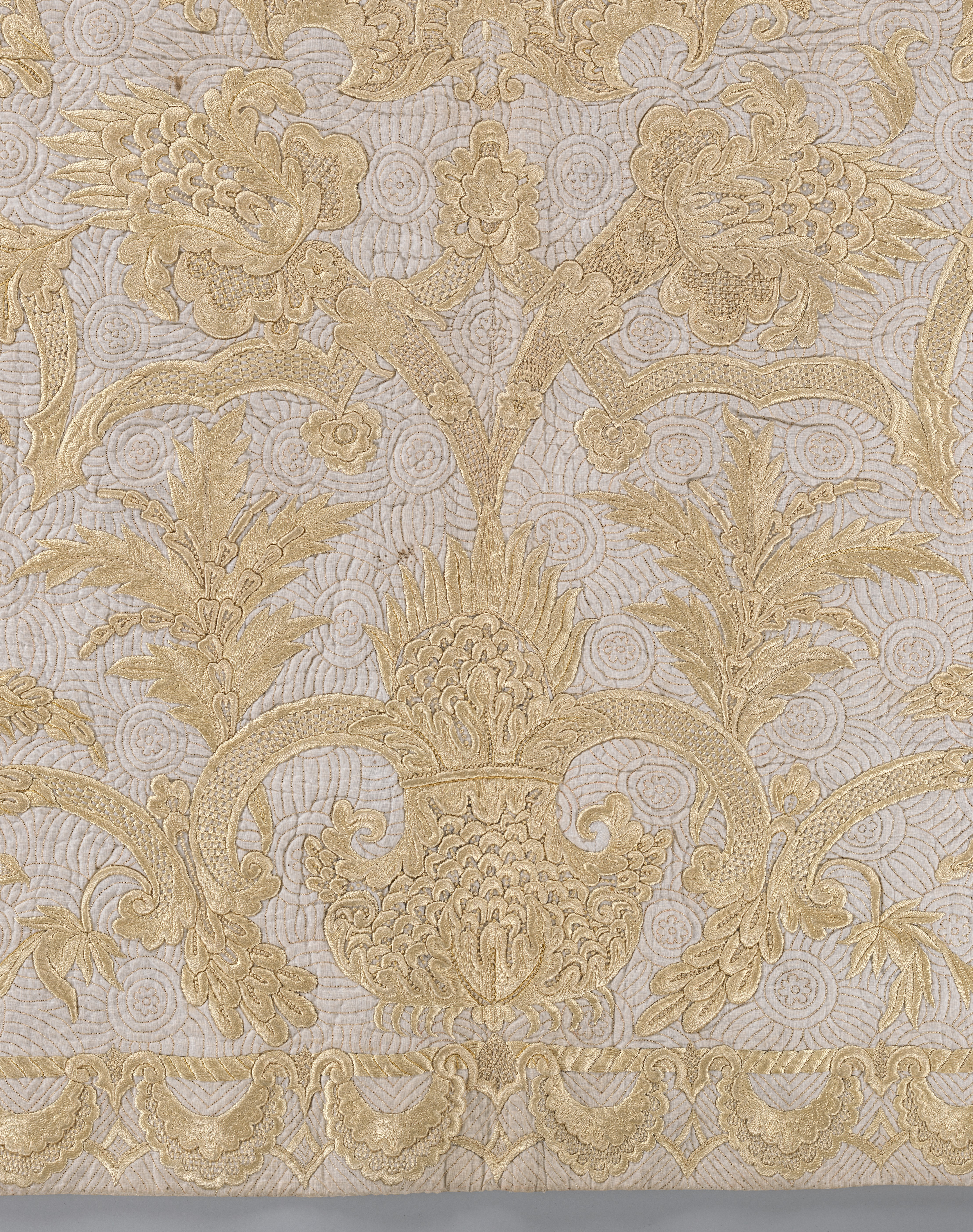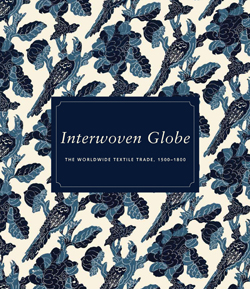Bedspread
Not on view
While the Portuguese were undoubtedly the first importers and consumers of the Indian embroideries made for the western European market, at least a few examples of these textiles did appear in England by the late sixteenth century. The 1601 inventory of Bess of Hardwick, Countess of Shrewsbury (1527-1608), included two quilts that were almost certainly products of this trade: "a quilt of yellow India stuff embroidered with birds and beasts" and "a quilt of India stuff embroidered with beastes."[1] Indian quilts of the type produced for the Portuguese market appeared with increasing frequency in London sales into the 1620s, when their value began to decline, perhaps because of diminishing novelty.[2]
The taste for Indian-style embroidery remained, however, and it is interesting to note that the English maker of this textile used not only the Indian palette of golden yellow on white but also an imported Indian cotton as the foundation. The cover has rare seventeenth-century marks on the plain-weave cotton fabric: the initials G.C.E. (for the English East India Company's original name, The Governor and Company of Merchants of London Trading into the East Indies) as well as three other stamps whose significance has not yet been deciphered.[3]
On this bedcover, the embroidered designs draw heavily on such exotic motifs as pineapple-like vegetation and serrated leaves, but contemporary European sensibilities are also evident in the strapwork connecting the floral elements. Additionally, the three-dimensionality of the embroidery and the use of stitches with long floats that create a shinier surface to contrast with the matte appearance of the cotton ground diverge from the Indian prototypes, whose flatter chain stitches are less glossy. English bedcovers were usually part of coordinated sets that could include bolsters, pillows, and matching valances[4]
In addition to the more common monochrome yellow-on white embroideries, Indian polychrome embroideries also arrived in England during the early seventeenth century. They, too, are described in sale records; for example, a 1614 sale included "a carpet or quilt embroidered upon calico with sundry silks."[5] The word "carpet" is probably used in its contemporaneous sense, that is, to signify decorative covers for a variety of furniture types, including beds. MMA 1970.173, an English polychrome silk and metal-thread bedcover, is more obviously dependent on the stylistic composition of Persian and Turkish carpets than this textile. By the eighteenth century, both embroidered and painted cotton textiles of this type, with a central medallion and smaller medallions in the corners of the central field, were being made in India for domestic consumption and for export.[6] These imported polychrome covers had a lasting influence on the production of English embroidered bed furnishings of the eighteenth century.
[Melinda Watt, adapted from Interwoven Globe, The Worldwide Textile Trade, 1500-1800/ edited by Amelia Peck; New York: Metropolitan Museum of Art; New Haven: distributed by Yale University Press, 2013]
Footnotes
1. Crill, "The Earliest Survivors?: The Indian Embroideries at Hardwick Hall," pp. 246, 260 n. 2; see also Levey, The Embroideries at Hardwick Hall, p. 390.
2. Crill, "The Earliest Survivors?: The Indian Embroideries at Hardwick Hall," p. 258.
3. Irwin and Brett, Origins of Chintz, p. 12. This East India Company mark first appeared in 1657, according to the India Office Archives; the other markings include one set of two Roman letters, and two symbols, at least one of which may be Tamil weaver’s marks of the type that, according to Margaret Hall (quoted in ibid., p. 12), occur at one end of the cloth near a shot of red cotton used to mark length.
4. MMA 34.104.1 has three coordinating pillows. In addition, there is a set with polychrome embroidery similar to MMA 1970.173 in the Victoria and Albert Museum, London (no. T.48A-E-1967). One of its pillows (no. T.48E- 1967) is illustrated in King and Levey, The Victoria and Albert Museum’s Textile Collection, p. 99, no. 109.
5. Crill, "The Earliest Survivors?: The Indian Embroideries at Hardwick Hall," p. 250.
6. Ibid.; for another painted version for the European market, see Irwin and Brett, Origins of Chintz, p. 98, no. 77, pl. 75
Due to rights restrictions, this image cannot be enlarged, viewed at full screen, or downloaded.
This artwork is meant to be viewed from right to left. Scroll left to view more.







